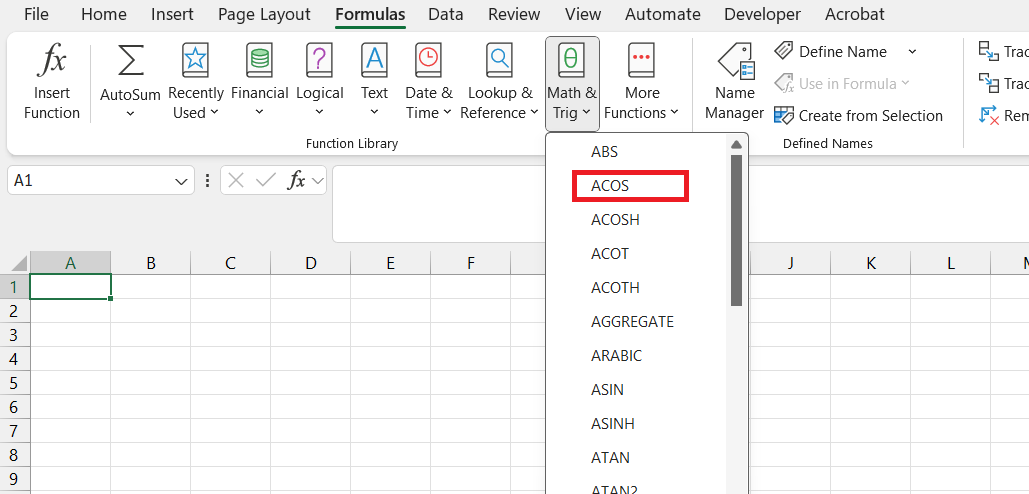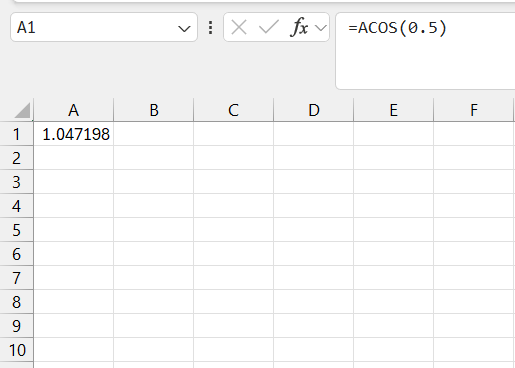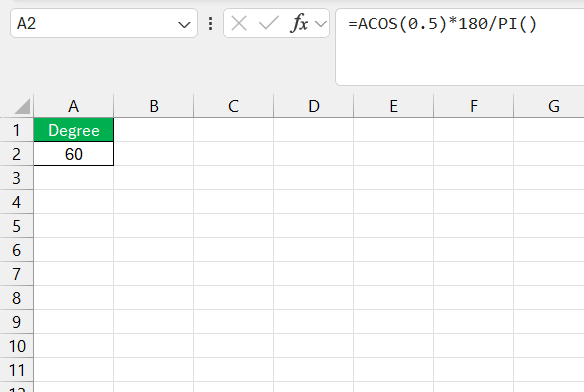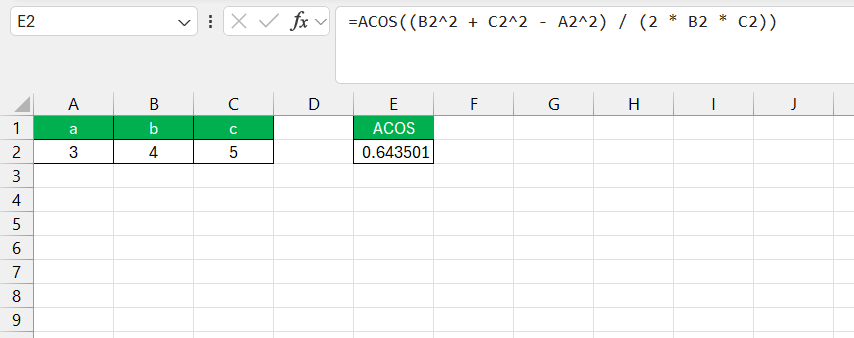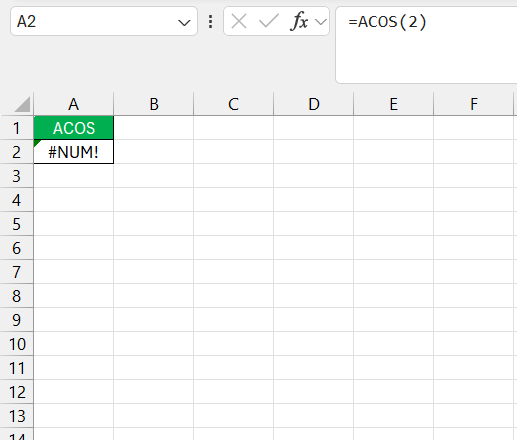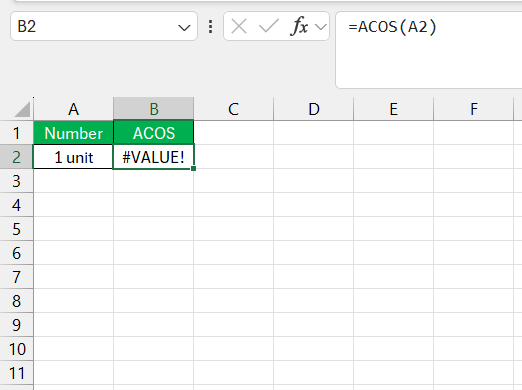When working with trigonometric functions in Excel, one common task is calculating the inverse cosine (also known as arccos). Whether you’re a math enthusiast, engineer, or data analyst, Excel’s built-in functions make handling trigonometry straightforward. In this article, I’ll walk you through everything you need to know about using the inverse cosine function in Excel, including practical examples and tips.
Key Takeaways:
- Excel’s ACOS function computes the inverse cosine, returning angles in radians for inputs between -1 and 1.
- Converting radians to degrees is essential for practical use, achievable with
*180/PI()or theDEGREESfunction. - ACOS aids in tasks like calculating angles in triangles and between vectors, making it vital for engineers and analysts.
- Common errors, like #NUM! and #VALUE!, arise from out-of-range inputs or non-numeric arguments, but data validation minimizes these issues.
- Alternatives like scientific calculators or Python provide flexibility, but Excel remains a robust tool for trigonometric calculations.
Table of Contents
Introduction to Inverse Cosine in Excel
Understanding the ACOS Function
In my daily work with Excel, I often turn to the ACOS function when I need to compute the arccosine, or inverse cosine, of a number. This mathematical operation is crucial for anyone engaged in trigonometry-related tasks.
With ACOS nestled within Excel’s “Math and Trigonometry” category, it’s tailored to calculate the angle in radians when I’m given the ratio of the length of the adjacent side to the length of the hypotenuse in a right-angled triangle.
It’s imperative to remember this function operates within the domain of -1 and 1, mapping out the angle whose cosine is the specified number.
Importance of Mastering ACOS for Data Analysis
I’ve come to appreciate that mastering ACOS in Excel is not merely about crunching numbers – it’s about unveiling the stories hidden within our data. To be adept in deciphering intricate wave patterns or the engineering precision required while constructing edifices that kiss the sky, I rely on ACOS to provide the precise angles needed.
Understanding the nuances of this function empowers me to analyze and interpret scientific data with higher precision, making it indispensable in fields like engineering, physics, or any area necessitating such trigonometric insight. Embracing ACOS is more than learning a function; it’s about gaining a deeper comprehension of the underlying physics and enhancing the integrity of data analysis.
Step-by-Step Instruction on Using ACOS
Basic Syntax of the ACOS Function
When I use the ACOS function, I adhere to a very straightforward syntax:
=ACOS(number)
Here, ‘number’ is the required argument and represents the cosine of the angle I’m attempting to find.
It’s crucial that ‘number’ stays within the boundary of -1 to 1 because that’s the valid range for a cosine function. Any deviation, and I’ll confront an error message, halting my progress. The function dutifully returns the angle in radians corresponding to the cosine value, and this simplicity in its syntax makes it an appealing feature to have in my analytical arsenal.
Converting Results From Radians to Degrees
I have noted that angles are typically expressed in degrees rather than radians in many practical applications, thus converting results from radians to degrees is a common task. The ACOS function returns the angle in radians, but I can easily convert this to degrees by multiplying the result by 180/π.
Alternatively, Excel’s DEGREES function streamlines this conversion. For example, suppose I calculated the arc cosine of 0.5, using either =ACOS(0.5)*180/PI() or =DEGREES(ACOS(0.5)) will give me 60 degrees.
This dual approach provides flexibility depending on the complexity I might be dealing with in my formulas. This transformative step enables me to present my data in a more comprehensible format, especially when degrees are the standard unit of measurement for the intended audience or application.
Practical Examples of ACOS in Action
Calculating Angles Between Vectors
I find that calculating the angle between two vectors is a practical and compelling feature of Excel’s capabilities, especially for spatial analysis. Given two vectors in three-dimensional space, delineated by their components, I can determine the angle between them with elegance and efficiency.
First, I calculate the distance between the vectors using the distance formula. Then, by finding the dot product and magnitude of these vectors, I can derive the cosine of the angle that separates them.
Inputting this cosine value into the ACOS function, which is as simple as =ACOS(cosine), grants me the answer in radians. Multiplying this by 180/PI() as previously mentioned hands me the degree measure for this angle. This method is splendidly straightforward, offering a robust solution for anyone dealing with geometry, physics, engineering, or even graphic design.
Determining the Angle of a Triangle Using ACOS
When I’m tasked with determining the angle of a triangle using ACOS, it captivates me how trigonometry is seamlessly woven into Excel’s fabric. With the lengths of the triangle’s sides, I can calculate the cosine of the angle using the Law of Cosines. Here’s the formula I employ: =ACOS((b^2 + c^2 - a^2) / (2 * b * c)). This is based on the scenario where a, b, and c represent the lengths of the sides, and I’m solving for the angle opposite side a.
The result returned by ACOS is then measured by the desired angle in radians. Keeping in mind Excel’s flexibility, I can convert this result into degrees if necessary for a more intuitive understanding or for reporting purposes. This direct application of ACOS in calculating a triangle’s angle showcases the function’s vital role in fields like civil engineering, architecture, and even in educational domains where geometry plays a pivotal role.
Common Pitfalls and How to Avoid Them
Dealing With ACOS Function Errors
Encountering errors is a natural part of the learning curve. However, understanding these hiccups can significantly streamline my ACOS function experience. Let’s decode some common errors and how to fix them:
- #NUM! Error: This pops up if the number I’m trying to find the arccosine for is outside the -1 to 1 range. I always double-check my inputs to ensure they fall within these bounds.
- #VALUE! Error: I’ll see this if my argument is non-numeric. Excel expects a number as an argument for the ACOS function, so I ensure my inputs are numbers or cell references to numbers.
A quick tip for troubleshooting: I use Excel’s Formula Auditing tools. They can help trace and monitor formula calculations, making it easier to spot where things might have gone awry. I find that the more I experiment with ACOS, the more adept I become at navigating through these common pitfalls.
Ensuring Accuracy in Your Inverse Cosine Calculations
To ensure accuracy in my inverse cosine calculations, I maintain a rigorous approach. Precision begins with input verification; I make certain that values fed into the ACOS function are within the -1 to 1 range. Additionally, I often implement Excel’s built-in data validation features to safeguard against invalid inputs right from the start.
Another best practice I’ve adopted involves avoiding manual data entry when possible; by referencing cell values or formulas, I minimize human error. And, for results in degrees, I use Excel’s DEGREES function post-calculation to maintain consistency and accuracy across my worksheets.
Ultimately, I ensure my formulas are meticulously crafted and regularly revisited. Regular auditing and cross-checking with alternate calculation methods can be invaluable for confirming the soundness of my results.
FAQs
Is there an inverse function in Excel?
Yes, Excel provides several inverse trigonometric functions, each corresponding to a primary trigonometric function. These include ACOS for inverse cosine, ASIN for inverse sine, and ATAN for inverse tangent, among others. These functions enable us to calculate angles from their trigonometric ratios within Excel easily.
What Exactly Is an Inverse Cosine?
An inverse cosine, often denoted as cos^-1 or arccos, is a function that calculates the angle whose cosine is a given number. Precisely, it answers the question “What angle has this cosine value?” In a right-angled triangle, it’s the angle whose adjacent side-to-hypotenuse ratio is known, lying within the range of 0 to 180 degrees or 0 to π radians. It’s a fundamental concept in trigonometry and crucial for various mathematical computations.
How Can I Convert ACOS Results to Degrees in Excel?
To convert ACOS results from radians to degrees in Excel, multiply the output by 180/PI() or use the DEGREES function. For example, =ACOS(0.5)*180/PI() returns the angle in degrees directly. Alternatively, =DEGREES(ACOS(0.5)) accomplishes the same, providing a clean conversion.
Can I Calculate Inverse Cosine If I Only Have Side Lengths?
Yes, if you have the lengths of the adjacent side and the hypotenuse of a right-angled triangle, you can calculate inverse cosine. Use =ACOS(adjacent_side/hypotenuse) in Excel to find the angle in radians, and convert to degrees if needed using =DEGREES(ACOS(adjacent_side/hypotenuse)).
Are There Any Alternatives to Excel for Computing Inverse Cosine?
Certainly, there are numerous alternatives to Excel for computing inverse cosine, such as scientific calculators, programming languages like Python with math libraries, online trigonometric calculators, and other spreadsheet software like Google Sheets, which also offers an ACOS function. Each tool has its advantages depending on the complexity of the task and user preference.
John Michaloudis is a former accountant and finance analyst at General Electric, a Microsoft MVP since 2020, an Amazon #1 bestselling author of 4 Microsoft Excel books and teacher of Microsoft Excel & Office over at his flagship MyExcelOnline Academy Online Course.

